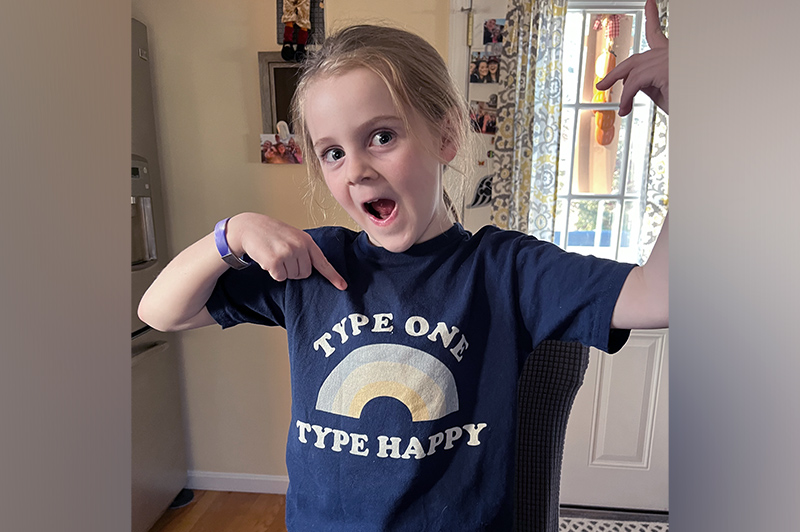Emmie’s journey with type 1 diabetes and celiac disease

Emmie knows more about her own medical history than most children her age. Her journey to finding answers started when she was just 4 years old. She woke up one day looking “like I ate a bunch of blueberries or blackberries — my lips were turning blue,” explains Emmie, now 7. Her mom, Amanda, wasted no time and took her to the closest hospital to figure out what was happening. Once they arrived, her lips had turned back to red, but the hospital staff still wanted to run blood tests to find out what could have caused this reaction.
The first tests of many
Her test results were shocking. “They told us that her blood sugar level was high, in the 500 range, but we didn’t know what that meant,” shares Amanda. Emmie was diagnosed with type 1 diabetes, an autoimmune disease in which the body’s immune system attacks and destroys the cells in the pancreas that make insulin (beta cells). As a result, the body cannot produce enough insulin to regulate blood sugar.
Once Emmie was diagnosed, she was transferred to Boston Children’s Hospital for her care.
At Boston Children’s, Amanda and her husband were given information from the Diabetes Program about how to check Emmie’s blood glucose levels and other treatment information about type 1 diabetes. “It was a learning curve,” says Amanda. “But we were connected to so many incredible resources to help us take on this challenge.”
Amanda shares that something that really stood out to her was how Boston Children’s offered support from all angles. “They understand that you need to care for the whole child,” explains Amanda. “We were connected to endocrinologists, a diabetes educator, an endocrinology social worker, financial support services, and so many other support services — adults in the same situation don’t always receive these resources, so it was incredible.”
Amanda knows this firsthand: Fourteen months after Emmie’s diagnosis, she was also diagnosed with type 1 diabetes. With both Emmie and Amanda on this journey together, they learned that many people with type 1 diabetes may also have celiac disease, which is a lifelong intolerance to gluten, a protein found in wheat and some other grains.
The importance of checking labels
One year after living with type 1 diabetes, Emmie tested positive for celiac disease. “Emmie’s endocrinologist, Dr. Joseph Wolfsdorf, called us on the weekend because he wanted to tell us directly that she had celiac disease,” says Amanda.
Soon after an endoscopy confirmed her celiac diagnosis, Emmie and her mom joined the Celiac Kids Connection, which, according to both of them, has been a major support system. “Right when we signed up, we got a welcome basket in the mail filled with gluten-free foods and snacks that we hadn’t known about. We were also connected to an outreach volunteer — a mom whose child also was living with type 1 diabetes and celiac disease,” shares Amanda. “That connection was so incredibly valuable to us, because it helped us know that we weren’t alone in this, and the community was there for us.”
For long-term care, Emmie has a check-up once a year with Dr. Dascha Weir in the Celiac Disease Program. Every six months, she visits Dr. Wolfsdorf and the endocrinology team to undergo blood tests and make sure everything looks good. Then, Emmie visits her diabetes nurse educator and her nutritionist, who monitor her growth and wellness.

Advocating for the health of others
With a full team to help her, Emmie wants to help other kids who might not have the same resources.
Earlier in July, she and Amanda traveled to Washington, D.C., to advocate for better care and access to insulin for other children with diabetes, and for those who also have a dual diagnosis of type 1 diabetes and celiac disease. “The more people know about Emmie’s diagnoses, the safer she and others like her will be,” says Amanda. “Emmie is using her own voice, sharing her story, and advocating for others like her — she’s really incredible.”
When Emmie isn’t advocating for others and educating adults around her about type 1 diabetes or celiac disease, she’s an artist, dancer, singer, and avid reader. “Emmie can do anything, and she wants to see other kids achieve their dreams too, regardless of their diagnosis.”
Learn more about the Celiac Disease Program and Diabetes Program.
Related Posts :
-

New genetic insights could change how we treat, and talk about, polycystic ovary syndrome
Polycystic ovary syndrome (PCOS) has long been viewed as a hormonal disorder affecting women of reproductive age. However, ongoing research ...
-

Are weight-loss medications and surgery right for teens?
Advances in bariatric surgery and weight-loss medications have made weight management accessible to more adults. But are these approaches effective — ...
-

Addressing food insecurity and nutrition challenges in pediatric type 1 diabetes care
Managing type 1 diabetes can be overwhelming for children and families. As children learn to live with the disease, many cut ...
-

Could peripheral neuropathy be stopped before it starts?
An increase in high-fat, high-fructose foods in people’s diets has contributed to a dramatic increase in type 2 diabetes. This, ...





